Course:EOSC270/2023/Group 9 - Cause and Effect: Ghostfishing
What is the problem?
Ghostfishing is anthropogenic marine phenomenon caused by the leftover (lost, abandoned or otherwise not used) fishing equipment that is left within marine environments, and the subsequent environmental impacts this gear has when it continues to function unmanned .
Types of ghostfishing equipment
Gillnets

Gillnets are nets with a buoyant top line and weighted bottom line. Between these is a vertically suspended net that catches any fish that swim into it. The perpendicular arrangement of the nets is intended for catching fish by their gills, or tangling them so they cannot swim out. Gillnets are lost when the top or bottom line is dislodged, and travel via currents, trapping wildlife along the way. Gillnet hole sizes may be small as 30mm or large as 300mm - depending on the size of the holes, may affect a greater variety of bycatch.
Trammel nets
Trammel nets are modified gillnets with three layers of netting. Sandwiched between two larger meshes is a fine mesh that traps fish the same way a gillnet does. Like a gillnet, trammel nets also contribute to ghostfishing by trapping unwanted bycatch if lost. Due to the complex netting structure, they pose a risk to a greater variety of species, including mammals, crabs and cetaceans.
Traps

There are a variety of traps intended for different species, but all pose a risk to wildlife if lost at sea. The majority include pot/bottle traps, which are portable and allow movement in but not out. These pose a risk due to their convenient and efficient deployment – they are widely used but can be abandoned or lost easily. The buoyant ropes used to anchor them to deployed locations also pose a risk to marine life - mammals can get stuck in these ropes and die from starvation or lack of oxygen.
Ways that ghostfishing occurs
Roughly 640,000 tons of fishing gear is lost in the ocean yearly, totalling ~10% of overall marine debris lost. These nets and traps can come from different places and intents - malicious or not.
Illegal dumping
Much of the gear lost in the ocean comes from illegal or unethical dumping into the ocean because of evasion of disposal taxes and costs, driven by the development of newer and more efficient gear. Many illegal commercial fishers may dump their gear to prevent tracing from local port officials.
Lost or malfunctioning equipment
Seen in nets, many of these wear out over time or get stuck on benthic structures. To fishermen, these nets are replaceable because they’re cost-effective, so when a net gets stuck, it’s abandoned. In these cases, the net is left to drift down to the seabed where it’s stuck, ready to trap and kill fish that may get stuck in it.
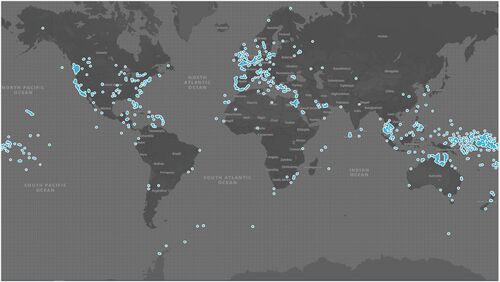
Where does this problem occur?
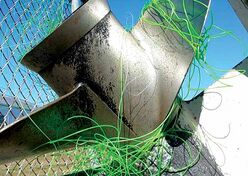
Location
Evidence of ghostfishing can be found across the globe, with a majority occurring North of or near the equator, although equipment could be found as far south as Antarctica[1]. This increase in discarded nets and traps found in the Northern Hemisphere shows how ghostfishing is due to industrial fishing supplying food to population centers. It also shows that ghostfishing occurs in countries that have higher GDPs and so can afford to discard their fishing gear[3]. Ultimately however, evidence of ghostfishing can be found worldwide.
Depth
Discarded at the surface, abandoned nets begin to gather biomass as organisms become stuck when they prey on other trapped organisms. Holding this extra weight, the nets can occasionally sink to deep water[4].Additionally, the little movement of water and smaller populations in deep environments results in very little biofouling. This biofouling would normally aid in the degradation of ghostfishing equipment but without ample water movement and biological activity, equipment persists for long periods of time in benthic communities. The location within the ocean also affects the depth and therefore the type of gear found. As traps and pots can only be placed at depths of up to 750m, traps and pots are much less frequent in bathypelagic environments (between 1000-4000m)[5].
Why is ghostfishing significant?
Effects on the organisms
As will be discussed later in this page, ghostfishing affects vast amounts of marine wildlife, at many depths. Even nets designed for shallow waters can eventually sink to the seafloor and affect the recolonization of organisms[6]. Because the nets last for so long, organisms accumulate in the equipment and draw in other predatory organisms or scavengers. However, these opportunistic organisms also fall victim to ghostfishing as they often are trapped as well[7]. The involvement of several trophic levels means that ghostfishing affects much more than the organisms it was designed to trap.
Effects on humans
Because ghostfishing affects so many parts of the marine food web, it also indirectly damages fish stocks as well, causing financial losses for the people who discard their nets[8]. Acknowledging and understanding the detriment ghostfishing causes the fishing industry is particularly important as it disincentivizes the negligent practices that lead to ghostfishing initially.
Discarded nets can even cause issues for industrial and recreational sea vessels, either obstructing channels for transport or trapping boats as nets become tangled in propellers and rudders[9].
Amount of fishing material lost
For much of history, discarded fishing material was not recorded. According to recent research, approximately 2% of all fishing gear is lost, totaling nearly 100000 km2 of lost gear, hundreds of thousands of longline mainlines and traps and pots estimated to exceed 25 million units[10]. This is important because not only does this waste interfere with aquatic life, but it is also a waste for the fishers themselves. 2% of all fishing gear being totally lost to the ocean is an expensive loss of energy and resources used to synthesize the gear in the first place.
Ghostfishing effects on marine ecosystems

Case studies
Cornwall, UK[12] : The World Society for the Protection of Animals (WSPA) studied the types and amount of ghost gear present along Cornwall's coast, as well as the risk to marine animals. They then gave severity ratings to the different types of abandonment fishing gear. Buoys were the most common lost equipment, but nets and pots posed the greatest risk.
Nova Scotia, CA[13]: An NPO group called Coastal Action collected lost and discarded lobster traps off the coast of Nova Scotia. Over 32 tonnes of gear were retrieved, some dating back to the 80s.
Bycatch species
Nearly any fish species may be affected by ghostfishing nets, depending on the type and size of the net holes used.
Depending on the size of the gillnet holes, these nets can target many small pelagic fish, and bigger fish like tuna, lumpfish, and halibut[14][15].

Trammel nets are similar to gillnets but have multiple layers and thus can catch a wider variety of marine organisms[16]. Due to the range of hole sizes and trapping styles of these nets, abandoned and partially damaged trammel nets may also entangle larger animals, including: Orcas, dolphins, porpoises, manatees, turtles, sharks, rays, seals, seabirds, and even the endangered dugong[17][18][19].
Pot traps and bottle traps are designed to catch benthic organisms including lobsters, crayfish, and a variety of crab. However, whelk, eels, cuttlefish, scup, small fish, and untargeted crab species may wander in and become stuck by these traps[20][21]. Over 90% of the species that get trapped in all nets and traps have a commercial value[22]. One study showed that a single abandoned net can catch $20,000 worth of Dungeness crab over a ten-year period[22].
This YouTube video shows a seal getting freed from an abandoned fishing net and other plastic on Walvis Bay in Namibia, and the effort it takes to save animals from ghostfishing equipment. Even if these species don't die in the fishing nets, many will be injured enough to impair them from swimming and functioning properly again.
Species vulnerability
The simple design of most fishing nets can trap fish by the gills or the appendages of mammals, especially when sections of the net are ripped for the larger animals to get stuck in. Smaller marine animals will hide under rocks and naturally occurring formations to escape from predators, and as they do so may accidentally force themselves into a hole of a fishing net that was also caught on the rocks[23]. Larger animals like whales may not see floating ghost gear until it's too late and get tangled. These mammals may also interact with ghost gear like in Figure 6., not knowing what it is and accidentally getting an appendage caught. As fish and other marine animals get caught in these nets, struggling makes the situation worse and most will become severely entangled.
What is the extent of the problem?
The severity of ghostfishing on marine ecosystems can be assessed through the financial consequences, ecological impact, and invasive potential of ghostfishing gear. It was found that ghostfishing has harmed and killed over 557 marine species, 66% of marine mammals, 50% of birds, and all species of sea turtles.[24] Furthermore, ghost gear was found to be four times more likely to entangle and impact marine life than any other form of human-generated marine debris.[25]
The Effects as Time Progresses
The possibility of gear loss and subsequent ghostfishing present themselves wherever fishing gear is used[26]. This is why ghostfishing and gear will continue to be problematic for as long as the fishing industry is alive, and afterward, as the gear survives in the water. One of the ever-growing masses of accumulating ocean debris, the Great Pacific Garbage Patch, consists of a colossal 46 percent of fishing nets [27]. Newer, durable synthetics help derelict gear survive in the environment for longer periods of time[28], allowing accumulation, and continuing to harm marine life for years after it has been left behind.
The danger of “ghost gear” is not exclusive to creatures living in the water, but the seabirds in the area, as well[29]. An example of the detrimental effects of ghostfishing can be seen in over a thousand nets found in the coastal waters of Washington, USA (Puget Sound), where about 400 were over a year old and still causing damage to marine life[28]. Nets are often buoyant and entangle life near the surface. However, they can also sink and smother benthic areas, damaging the habitats and residents within these communities[30]. The sinking occurs when nets become weighted with the catch of species like sea turtles, porpoises, sharks, and other large organisms, as well as the accumulation of small organisms, culminating in the damage of benthic specimens, like breaking corals[31]. Additionally, it is thought that this issue of ghostfishing is exacerbated by large numbers of pots and traps, as their relatively sturdy material prevents their breakdown [32]. With the passing of time and the increased presence of gear in the water, the trapping of animals exacerbates.
Why was This Allowed to Continue ?
Ghostfishing has been allowed to occur due to a combination of factors, including inadequate gear management, weak regulations and enforcement of fishing practices, a lack of incentives for fishers to retrieve lost gear, and a general lack of awareness about the environmental impacts of ghostfishing.
Fishers often discard or lose their fishing gear without attempting to retrieve it, leaving nets and gear in the water to continue capturing and harming marine life.
According to a study, around 25 million pots and traps are lost to the ocean every year, which contributes to the continuation of ghostfishing.[33] This behavior of not retrieving lost fishing gear can also be linked to education and awareness in fishing communities and is one of the main reasons found why ghostfishing has been allowed to continue to persist. As a later section will discuss, the failure to retrieve lost gear can result in financial losses for fishing communities. Therefore, understanding the impact of ghostfishing and the importance of responsible fishing practices can be a key factor in preventing the issue from continuing.
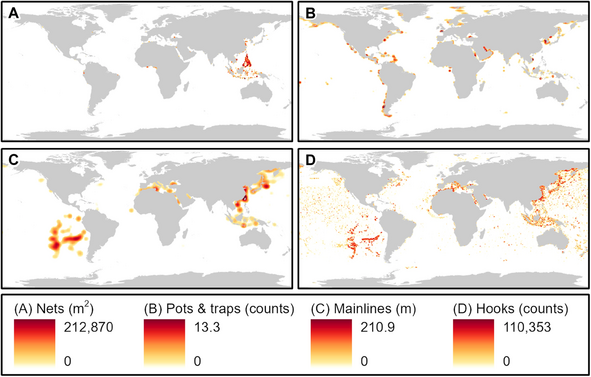
While some loss may be accidental, deliberate discarding is a major contributor to this issue which has ties to regulations in overfishing. Regulations are often focused on ensuring the sustainability of fishing, often overlooking the issue of ghostfishing, which can have the opposite effect and make the fishing industry less sustainable. However, even those regulations fail; according to FAO around 31% of the global fish stocks are overfished. Many of this illegal, unreported and unregulated fishing (IUU) happens at night which only increases the likelihood of purposeful abandonment and human error in usage of fishing gear. In addition, gear is often abandoned to avoid capture by authorities for overfishing.[25]
An Indirect and Long-term Effect
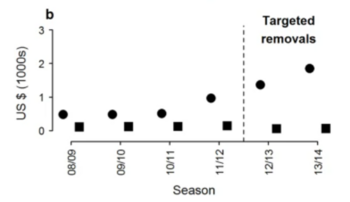
The abandonment of nets and traps can cause issues extending beyond environmental interference, creating socioeconomic complications. To communities that depend on the fishing industry, the employment of sustainable practices is essential to their means of living[32]. For example, a community in the Philippines experienced a 240 percent rise in fishing due to stock-damaging practices since 1960[34]. Derelict gear contributes to the destruction of a commonly shared resource by which fishermen earn their keep, perpetuated by the increase in deployed nets in an attempt to compensate for lost stock[35]. If there is no change to the standards surrounding fishing, economic loss will progress, whether that be from decreased catch or increased effort. Marine species are continually caught and killed without reason; this type of overfishing depletes the stock of potential profit, without allowing fishermen to reap the benefits of the catch[32].
Global estimates of removing under 10 percent of abandoned gear from crustacean fisheries lead to an annual approximation of $830 million USD in monetary gain to be reclaimed[32]. With such models, fishermen may be incentivized to practice more sustainable methods, motivated by the improvement that is sure to be seen when the fishing industry is void of unnecessary dumping. By these motivations, the likelihood of fishermen adhering to potential solutions increases.
Furthermore, the financial benefits of reducing ghostfishing underscore the need for increased education and awareness among fishing communities and stakeholders about the devastating impact of ghost gear on marine ecosystems and the potential economic gain that could be achieved through responsible fishing practices.[32] The scale of the problem is also often underestimated due to the fact that many occurrences of ghostfishing are IUUs[25], and there is a lack of awareness and education regarding the impacts of ghostfishing among fishing communities and the general public. As a result, it has not been a priority for many fishing communities and stakeholders to address the issue, and ghostfishing has been allowed to persist.[36]
Given the impact, what are the solutions?
While some ghostfishing impacts are intentionally anthropogenic, much of lost gear is due to poor weather conditions, accidents, or malfunction. Common proposed solutions include investing in biodegradable fishing gear, or fishing gear that will become escapable for trapped species after a certain time of disuse.
Another proposed solution is the retrieval of lost or damaged fishing equipment. This is a costly and time intensive project but has downsides and drawbacks. It has been discussed that retrieval of fishing gear may not be possible in certain cases where the gear cannot be found again, is in a place not conveniently accessible, or is located somewhere that may cause damage to the surrounding ecosystem and environment should retrieval methods take place there.
Local Solutions
Oceans and Fisheries Canada operates a Ghost Gear Fund[37]. The Fund provides grants that reduce marine plastics related to ghostfishing. Roughly 10 million CAD is invested into the program each year[38] funding over 40 projects in 2022. All projects receiving funding fall into at least one of the four following categories: ghost gear collection, appropriate disposal, purchase or development of technology, and international partnerships.
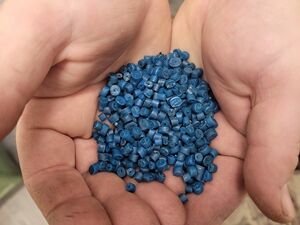
Work has already begun in Canada to reduce ghost gear in the region. Private firms based in British Columbia such as the BC Shellfish Growers Association and the Pacific Prawn Fishermen’s Association have received funding to retrieve ghost gear located near their facilities and expand safe disposal sites. Private advocacy groups and NGOs have also been involved. The Emerald Sea Protection Society, T Buck Suzuki Foundation, and many others are involved in ghost gear retrieval and prevention[39]. Recently a recycling facility in British Columbia opened that turns plastics from ghost gear into reusable plastic pellets for products like kayaks. It is estimated that over 739 tonnes of abandoned fishing gear was removed from the ocean due to the Ghost Gear Fund between January 2019 and December 2021[40].
Indigenous Partnerships
Indigenous communities and organizations have taken a lead on efforts to combat ghostfishing. 14 of the 37 projects funded by Fisheries and Oceans Canada were done in collaboration with Indigenous groups while 5 were led by Indigenous organizations[40]. The Torngat Joint Fisheries Board is one such organization. Funding these groups has a dual purpose: to foster environmental education and Indigenous stewardship while allowing for the search and retrieval of ghost gear in coastal regions[37]. The Malahat Nation removes ghost gear from the Salish sea through the combined efforts of dive teams, Elders, and a remote-controlled submersible. The First Nation also raises awareness about ghostfishing and suggests anglers avoid fishing in bad weather or leaving traps out long in order to prevent the loss of fishing gear[41]. Collaboration at the provincial level has also increased. The Marine Plan Partnership is an agreement between 17 coastal First Nations and the BC Government facilitating monitoring, stewardship and marine zoning to protect ecosystems from harm, including those caused by ghostfishing[42].
Global Solutions
Ghostfishing is a global problem and therefore requires global solutions. Despite this, most international organizations tasked with regulating the ocean do not have mandates mentioning ghostfishing and fewer have binding regulations to limit ghostfishing[43]. Regulation of ghostfishing varies greatly country to country. 40% of global fishing occurs in countries territorial water as such national regulations have a massive effect on global ghostfishing[44]. Global partnerships between companies, countries, and NGOs such as the Global Ghost Gear Initiative (GGGI) have seen some success. The GGGI provides funds for projects around the globe to clean up ghost gear. GGGI also compiles records of ghost gear sites in order to better target areas for retrieval[45]. Even with these efforts the vast majority of ghost gear in the ocean is untracked and continues to damage ecosystems[46] demonstrating that current solutions are insufficient.
References
- ↑ 1.0 1.1 Richardson, K.; et al. (2019). "Building evidence around ghost gear: Global trends and analysis for sustainable solutions at scale". Marine Pollution Bulletin. 138: 222–229 – via Elsevier Science Direct. Explicit use of et al. in:
|last=(help) - ↑ BoatU.S. (April 2015). "Removing fishline from props". BoatU.S.
- ↑ Lebreton; et al. (September 01 2022). "Industrialised fishing nations largely contribute to floating plastic pollution in the North Pacific subtropical gyre". Scientific Reports. 12: Scientific Reports. Explicit use of et al. in:
|first=(help); Check date values in:|date=(help) - ↑ Saldanha, H. J.; et al. (2003). "The use of biofouling for ageing lost nets: a case study". Fisheries Research. 64(2-3): 141–150. Explicit use of et al. in:
|last=(help) - ↑ NOAA Fisheries (March 14 2019). "Fishing Gear: Traps and Pots". NATIONAL OCEANIC AND ATMOSPHERIC ADMINISTRATION | U.S. DEPARTMENT OF COMMERCE. Check date values in:
|date=(help) - ↑ Angiolillo, Michela (2019). "World Seas: An Environmental Evaluation (Second Edition)". Academic Press: 251–268.
- ↑ Kühn, S et, al (2015). "Deleterious Effects of Litter on Marine Life". Marine Anthropogenic Litter: 75–116 – via Springer.CS1 maint: multiple names: authors list (link)
- ↑ NOAA Marine Debris Program. (2015). "Impact of "Ghost Fishing" via Derelict Fishing Gear" (PDF). 2015 NOAA Marine Debris Program Report. line feed character in
|title=at position 26 (help) - ↑ Fishing Booker Blog (2021). "Explained: Ghost Fishing".
- ↑ Richardson, K.; et al. (2022). "Global estimates of fishing gear lost to the ocean each year". Science Advances. 8, 41 – via Science. Explicit use of et al. in:
|last=(help) - ↑ "Grey seal in discarded net. Lundy Island, UK". Alex Mustard.
- ↑ "A case study on the impact of ghost fishing gear in Cornwall, UK" (PDF). WSPA.
- ↑ "33 tonnes of ghost gear pulled from Nova Scotia shores last year, group says". CBC News.
- ↑ "A SHORT DESCRIPTION OF GILLNET AND LONGLINE GEARS".
- ↑ "Small Mesh Gill Net Rules Modification". North Carolina Marine Fisheries.
- ↑ "Trammel Nets". Seafish.
- ↑ Duncan, EM (December 2017). [DOI 10.3354/esr00865 "A global review of marine turtle entanglement in anthropogenic debris: a baseline for further action"] Check
|url=value (help). Endangered species research. 34: 431–448 – via Inter-Research - Open Access. - ↑ Stelfox, martin (October 2016). [DOI 10.1016/j.marpolbul.2016.06.034 "A review of ghost gear entanglement amongst marine mammals, reptiles and elasmobranchs"] Check
|url=value (help). Marine pollution bulletin. 111: 6–17 – via ScienceDirect Journals. - ↑ Parton, KJ (July 2019). [DOI 10.3354/esr00964 "Global review of shark and ray entanglement in anthropogenic marine debris"] Check
|url=value (help). Endangered species research. 39: 173–190 – via Inter-Research - Open Access. - ↑ "Fishing Gear: Traps and Pots". NOAA.
- ↑ Kaiser, MJ (1996). "Catches in 'ghost fishing' set nets". Marine ecology. Progress series (Halstenbek). 145: 11–16.
- ↑ 22.0 22.1 "Ghost Fishing Gear is Killing Marine Life". Ocean Wise.
- ↑ "Ghost Nets - Tangled Up in Ghost Nets". Plastic Soup Foundation.
- ↑ "Ghost gear are the most lethal threat of plastic waste in the world". World Wide Fund.
- ↑ 25.0 25.1 25.2 "Ghosts beneath the waves" (PDF). World animal protection.
|first=missing|last=(help) - ↑ "Impact of "Ghost Fishing" via Derelict Fishing Gear" (PDF). National Oceanic and Atmospheric Administration.
- ↑ Lebreton, L.; et al. (March 2018). "Evidence that the Great Pacific Garbage Patch is rapidly accumulating plastic". Scientific Reports. 8. Explicit use of et al. in:
|first=(help) - ↑ 28.0 28.1 Gilman, Eric (October 2015). "Status of international monitoring and management of abandoned, lost and discarded fishing gear and ghost fishing". Marine Policy. 60: 225–239.
- ↑ Good, Thomas (January 2009). "GHOSTS OF THE SALISH SEA: THREATS TO MARINE BIRDS IN PUGET SOUND AND THE NORTHWEST STRAITS FROM DERELICT FISHING GEAR". Marine Ornithology. 37: 67–76.
- ↑ Richardson, Kelsey; et al. (January 2019). "Building evidence around ghost gear: Global trends and analysis for sustainable solutions at scale". Marine Pollution Bulletin. 138: 222–229. Explicit use of et al. in:
|first=(help) - ↑ Hancock, L. "Our oceans are haunted by ghost nets: Why that's scary and what we can do". Retrieved 2023-03-08.
- ↑ 32.0 32.1 32.2 32.3 32.4 32.5 Scheld, A.M.; et al. (January 2016). "The Dilemma of Derelict Gear". Scientific Reports. 6. Explicit use of et al. in:
|first=(help) - ↑ 33.0 33.1 "Global estimates of fishing gear lost to the ocean each year". Science Advances. 12 Oct 2022.
- ↑ Selgrath, Jennifer; et al. (March 2018). "Shifting gears: Diversification, intensification, and effort increases in small-scale fisheries (1950-2010)". PLOS One. Explicit use of et al. in:
|first=(help) - ↑ Parker, Laura. "These communities turn discarded fishing nets, or ghost nets, into carpets". Retrieved 2023-03-07.
- ↑ "Impact of "Ghost Fishing" via Derelict Fishing Gear" (PDF). 2015.
|first=missing|last=(help) - ↑ 37.0 37.1 "Ghost Gear Fund". Government of Canada Fisheries and Oceans.
- ↑ "The Government of Canada is proud to commit $10 million to combat ghost gear through Canada's Ghost Gear Fund and by partnering with the Global Ghost Gear Initiative". United Nations Department of Economic and Social Affairs: Sustainable Development.
- ↑ "Vancouver Island firms included in $8.3M grant to clean up 'ghost' fishing gear". CTV News Vancouver Island.
- ↑ 40.0 40.1 "Canada's Ghost Gear Fund delivering results for cleaner oceans". CISION Canada.
- ↑ Moreton, Bailey. "Malahat Nation working to remove 'ghost gear' from Salish Sea". Vancouver Island Free Daily.
- ↑ "Marine Plan Partnership for the North Pacific Coast (MaPP)". MaPP.
- ↑ Gilman, Eric. "Status of international monitoring and management of abandoned, lost and discarded fishing gear and ghost fishing". Science Direct.
- ↑ Cheney, Catherine. "How to protect, and why to prioritize, coastal waters". Devex.
- ↑ "PROTECTING OUR OCEAN AND THE LIFE WITHIN IT". Global Ghost Gear Initiative.
- ↑ Langedal, Gjermund, Aarbakke, Bård, Larsen, Finn, Stadig, Charlotta (2020). Clean Nordic Oceans main report - a network to reduce marine litter and ghost fishing. Nordic Council of Ministers. pp. 31–34. ISBN 978-92-893-6560 Check
|isbn=value: length (help).CS1 maint: multiple names: authors list (link)